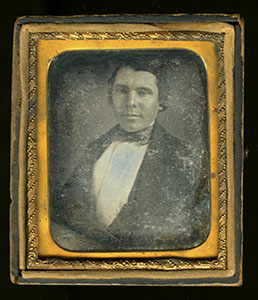Friday, March 22, 2019
How Have Our Photos Changed Since the 19th Century?
Hanne Pearce
Friday, March 22, 2019
BPSC
,
graduate students
,
peel
,
special collections
,
staff
,
students
,
workshops
No comments
:
I immediately signed up for “19th century photographic prints” as I am a freelance photographer outside my work at the library. I’ve always been intrigued by old photographs as they reveal unspoken aspects about life in a different time.
We live in an era where the digital photograph has made photographs mundane everyday tools. We snap selfies of ourselves in the mornings when we’re having a particularly good hair day, we shoot funny things we witness on our way to school or work and the every-day electronic exchange of photos can make us take them very much for granted. How often do we look at our photos and how many of them become forgotten on our devices? In a world full of photos, it is difficult to conceptualize a time when photographs did not exist.
One of my favourite reads of the past year was Capturing the light : the birth of photography, a true story of genius and rivalry by Roger Watson and Helen Rappaport. The book details the haphazard history of how photography was invented and the many players (Niépce, Daguerre and Henry Fox Talbot to name a few) that played a role in its development. With these ideas on my mind lately, I was quite excited when I saw the workshop on 19th century photographs workshop as an opportunity to learn from experts about how photography was practiced in the past, and to actually see examples of the different types of prints in person.
Bruce Peel Special Collections Conservator Carolyn Morgan lead the session which showcased many different types of early photographs. Starting with early Daguerreotypes, Ambrotypes, to Tintypes, Carolyn explained the processes by which these different types of prints were created.
One of my favourite reads of the past year was Capturing the light : the birth of photography, a true story of genius and rivalry by Roger Watson and Helen Rappaport. The book details the haphazard history of how photography was invented and the many players (Niépce, Daguerre and Henry Fox Talbot to name a few) that played a role in its development. With these ideas on my mind lately, I was quite excited when I saw the workshop on 19th century photographs workshop as an opportunity to learn from experts about how photography was practiced in the past, and to actually see examples of the different types of prints in person.
Bruce Peel Special Collections Conservator Carolyn Morgan lead the session which showcased many different types of early photographs. Starting with early Daguerreotypes, Ambrotypes, to Tintypes, Carolyn explained the processes by which these different types of prints were created.
Laid out on the tables in the Peel Library these photos, most of which were portraits, all exhibited different features depending on the processes that were used to create them. Some were dark and very detailed, others were faint or looked almost like drawings rather than photographs.
One of the key things I learned is that Daguerreotypes were printed on a sheet of silver plated copper, and they can easily be identified by their mirror-like surface. Daguerreotypes as were often encased in a frame to prevent tarnish.
 |
| Daguerreotype example |
One of the key things I learned is that Daguerreotypes were printed on a sheet of silver plated copper, and they can easily be identified by their mirror-like surface. Daguerreotypes as were often encased in a frame to prevent tarnish.
 |
| Tintype example |
Later Tintype photos were imprinted onto iron plates (metal) and Ambrotype were on glass with a dark paper or material backing.
 |
| Ambrotype example |
The workshop reinforced how early photography was expensive and only really the wealthy could really afford to have photos taken. It also revealed to me how one of my favourite past times was once heavily linked with chemistry and chemical processes.
I often wonder what the earliest photographers would think about how we now snap pictures of our food to disseminate with everyone we know, or text shots of store shelves as information to a friend or partner who is not present. Even though our digital equivalents manifest instantly and can be sent across the world in seconds, our photos still reveal details of our lives and are very much a part of the history photography. I only hope someday hundreds of years from now, people will be able to view them with the same fascination as we view early photographs.
Look for upcoming Bruce Peel workshops you can go to the library workshop page and filter the sessions for just Bruce Peel Special Collections.
You can also read more about 19th Century Photography in books from our collection.
I often wonder what the earliest photographers would think about how we now snap pictures of our food to disseminate with everyone we know, or text shots of store shelves as information to a friend or partner who is not present. Even though our digital equivalents manifest instantly and can be sent across the world in seconds, our photos still reveal details of our lives and are very much a part of the history photography. I only hope someday hundreds of years from now, people will be able to view them with the same fascination as we view early photographs.
Look for upcoming Bruce Peel workshops you can go to the library workshop page and filter the sessions for just Bruce Peel Special Collections.
You can also read more about 19th Century Photography in books from our collection.
Subscribe to:
Post Comments
(
Atom
)






No comments :
Post a Comment